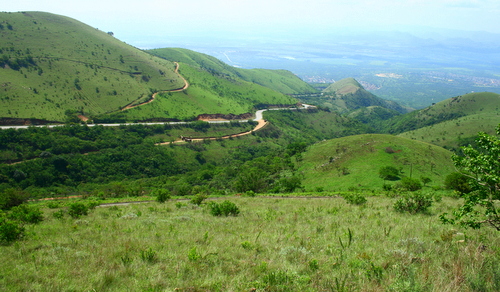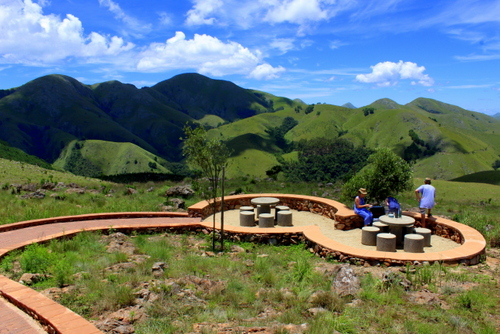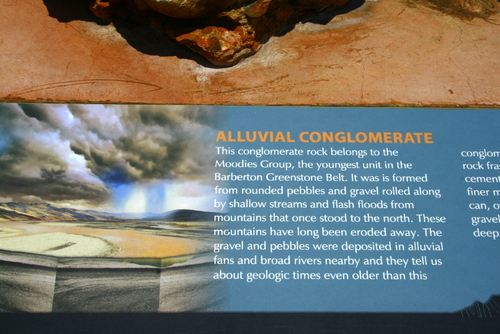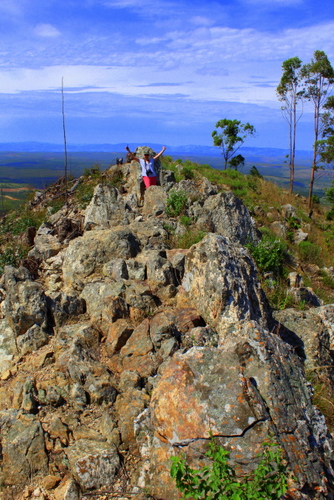A quest to find the birthplace of my paternal grandmother, Josephine (Josie) Nesbitt, found me rattling along the road between Badplaas and Barberton. I had been told there was a house, now included in the local Barberton Heritage Walk, that had belonged to someone who shared her maiden name.

As it turned out it could not have been her home because she had been born on the 8th of August, 1888 and left shortly afterwards in an ox wagon bound for Gazaland whereas the beautiful old building I found myself admiring had only been erected in 1902.
Belhaven was, nevertheless, a very fine house furnished, according to a brochure I picked up in its rooms, in the style of the late Victorian and early Edwardian periods and depicted “the lifestyle of a wealthy middle class family”. No longer inhabited it has been curated and turned into a museum; become a tourist attractive ‘objet’, a slice of authentic gold mining town Africana.
Built of corrugated iron with a wrap around verandah and elaborately ornamented rooms it hearkened back to an era when family life was much more rigidly formalised than it is today. There was a smoking room where only men were allowed to gather and another room reserved exclusively for the use of the womenfolk. Children, presumably, were not allowed to enter either.
In terms of social status and breeding it’s original occupants were clearly a cut above a lot of the riff raff who had come pouring into the Barberton area hoping to strike it rich it what was to become South Africa’s first major gold rush. Their legacy can still be seen today in the numerous old diggings, abandoned shafts, prospecting trenches and slime dumps that litter the surrounding countryside
Starting off as a forlorn grid of dirt streets, grubby tents and mouldering shacks, Barberton quickly evolved, in classic Wild West style, into a bustling frontier town full of hotels and bars frequented by thirsty miners and prostitutes, the most notorious of whom was undoubtedly “Cockney Liz”. At the height of its boom years it even boasted its own Stock Exchange.
Although long gone the departed fortune seekers still continue to haunt the landscape in one important way, mapping it with names, evoking both hope and despair, such as Revolver Creek, Joe’s Luck, Honeybird, Fever Creek and Eureka.
Still rummaging around in the detritus of other people’s lives I stumbled upon yet another family link. The first major gold strike had, in fact, been found on a farm in the De Kaap Valley that had been granted to another very distant ancestor of mine, George Pigot-Moodie, by the Boer Republic Government as a reward for his abortive efforts to promote the construction of a railway line between Pretoria and Lourenco Marques.
At the time he had made himself highly unpopular by first offering a reward and generous terms to anyone who discovered gold on his farm and then attempting to forcibly eject the hordes of prospectors who had gathered on his property when they did just that.
Any lingering ill feelings his somewhat high-handed actions may have generated do not appear to have permanently harmed his reputation. He continued to prosper and double-barreled his parents’ name when he became Member for the West in the Cape Town Legislative Council and purchased Westbrooke in Rondebosch – destined to be the future Cape Town residence of the Governor-Generals of the Union of South Africa.
The fact that the area filled in a few missing entries in my own family history is not, of course, its sole claim to fame. In geological terms it is, literally and figuratively, a veritable gold mine, so much so that it has now been declared a World Heritage Site.

Not only does it contain some of the world’s oldest known rocks but because the world’s oldest fossils have also been found there, the area has become a Mecca for scientists interested in how the young earth worked 3 500 000 millennia ago, and in searching for clues to the origins of life. Just in case you thought this was not enough to justify its elevated status the area also contains the earliest evidence of meteorite impact on earth, as well as the world’s earliest known gold deposits.
Cashing in on this impressive CV the local tourist authority have created the Barberton-Makhonjwa Geotrail which runs up into the mountains behind the town and eventually ends in Pigg’s Peak in Swaziland.
I took a drive up this road skirting buttock-like clefts and exposed rock faces striped with alternating shades of colour like a layered birthday cake. There are eleven marked stopping points along the way where you can get out and survey the folded masses of rock in front of you, each one telling a different geological story.
In places abandoned mine workings pock the hillsides like rodents burrows; long tongues of grey debris descending from their small black mouths. There had obviously been rain for the whole mountainside was a study in greens while the sky itself became an even more brilliant blue the higher up we got.

We stopped for lunch at the picnic site on the crest of a ridge. The view was superb – a lush and verdant, rolling green landscape stretching away as far as the eye could see. Puffs of white, cotton wool- like cloud floated overhead, in places blocking out the sun, so that some valleys were all alight and some sunk in dark shadow.
Even the name Makhonjwa has a magical ring. As with many mountains in Africa, local belief has it that you must never point your finger at them.
It was here I found one last link to my past – an entire layer of geological strata named after the same relative on whose farm gold had first been found in payable quantities.

As I headed homewards, well pleased with all my discoveries, I wondered how many other people could say they had had a pile of very old rocks named after one of their kinsfolk?
FOOTNOTE: Possibly attracted by the discovery of gold on “Moodies Concession” my great-grandfather, John Warren “Jack” Nesbitt, moved up to the Barberton district in 1888. It was here his young wife , Sarah, who was distantly related to George Pigot-Moodie, gave birth to my grandmother, “Josie”.
After a bit more research I discovered that she had spent the first few years of her life on a farm called White Hills, just off the main Barberton to Badplaas road, at the foot of the Nelsberg Pass. The farm – now part of a much larger timber plantation – gets its name from the prominent quartz outcrop in the area (funnily enough, the farm we settled on in the then Rhodesia was called Witte Koppies for the same reason).
We took a drive out there to see what we could find. Although we had a good look around we could not find any trace of the old homestead or anything else to remind us of their brief soujourn there.

My great grandfather arrived with his wife and two children in the early 1880’s before the gold rush and the town was known as Blandstowm until the Barbers came to town. There is a street in the town called Bland street.
I have a gold nugget that my grandfather found which is mounted on a brooch.He then started transport riding between Barberton and Delagoa Bay for Duncan(later Gen.) McKenzie and then to Zim via Beira and Chimoia
LikeLike
Thanks for sharing Hugh. I had no idea your ancestors were one of the early torch-bearers in the area or that they once had the honour of having a town named after them. The Nesbitt’s – who I mention – didn’t stay there long but joined the Moodie Tek bound for Gazaland.
LikeLike
A really interesting post, Ant. Would love to do another sibling trip up there someday.
LikeLike
Great post Ant! The area has now got world heritage status. Looking forward to more travels!
LikeLike
Thanks, Pen. Just sorry I had to postpone my trip up to your part of the world.
LikeLike